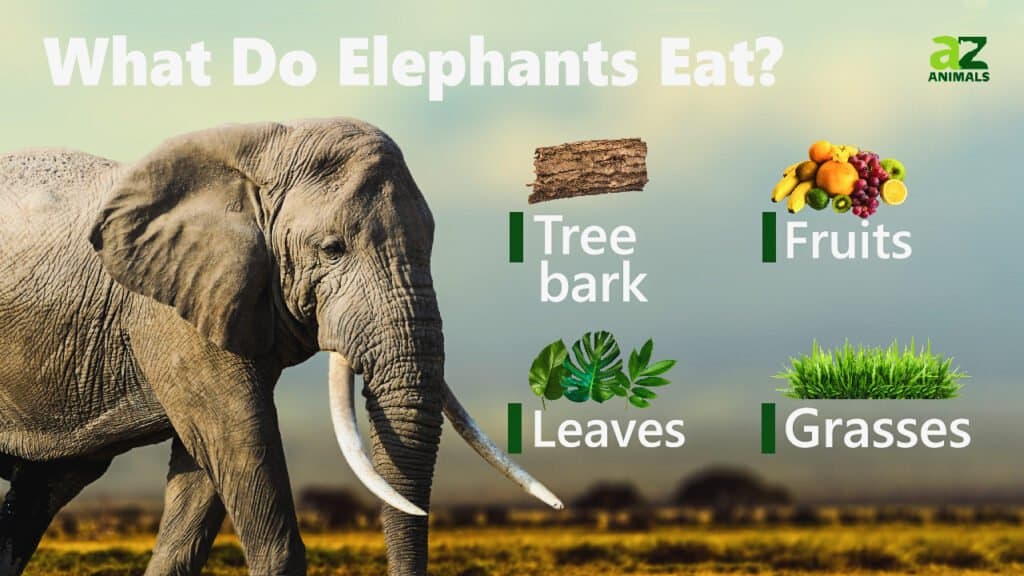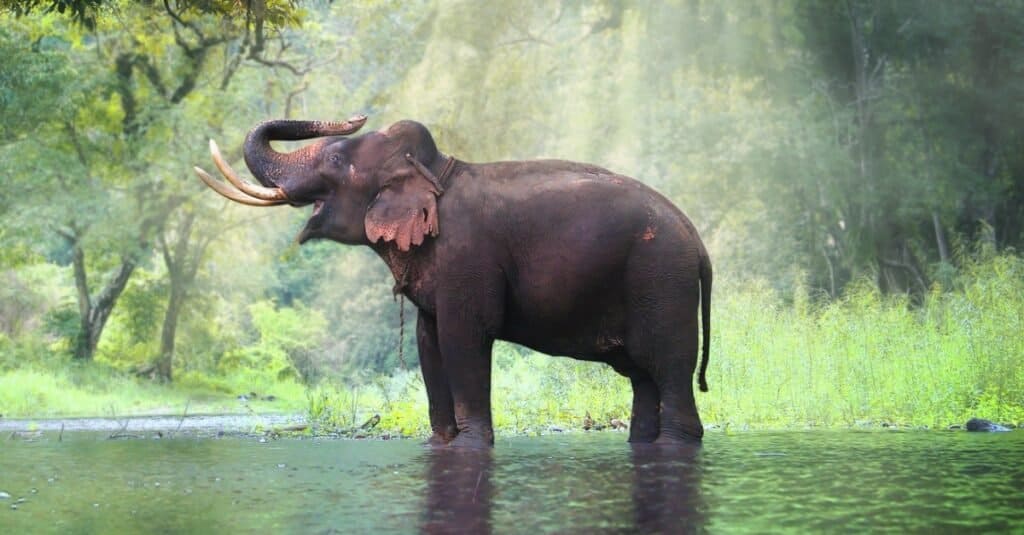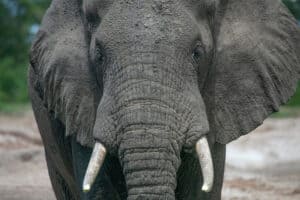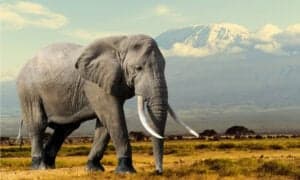
Key Facts
- On average elephants weigh between 2,700 – 4,000 kg.
- Eating enough for all those kilos requires hours and hours of endless munching.
- What do elephants eat? Well naturally, these lovable pachyderms enjoy a bit of variety with even a bit of dessert on the menu.
As the largest land mammals on the planet, elephants have similarly large diets to sustain their massive bodies on long treks through their native habitats. But what do elephants eat?
Incredibly, these herbivorous gentle giants typically graze for up to 18 hours a day, using their powerful trunks and tusks to retrieve and eat hundreds of pounds of various types of grass, shrubs, fruit, and other plant material! In addition to their massive size, their digestive systems aren’t particularly efficient, so they only digest and utilize around 40% to 60% of the food they eat each day.
Today, three unique species of elephants are recognized by biologists: the African bush elephant, the African forest elephant, and the Asian elephant. Let’s explore what each species of elephant eats, as well as where they live and their morphological and dietary differences.
What Do Elephants Eat: The Full List

An elephant taking a fruit
©tiverylucky/Shutterstock.com
Elephants eat foods that include:
- Tree bark
- Savanna grasses
- Fruits (like mangoes and figs)
- Roots
- Flowers
- Leaves
- Soil (for salt and minerals like iron and potassium)
- Stems and roots
- Grasses
- Local crops such as rice, bananas, and sugar cane
Yet, a list of what elephants eat wouldn’t be complete without analyzing what different elephant species eat. After all, Asian elephants that live in dense rainforests have very different diets than African bush elephants living in sub-Saharan Africa! Let’s examine the diet of each elephant species individually.
What Do African Bush Elephants Eat?
The African bush elephant, also commonly known as the African savannah elephant, is one of two remaining species of African elephants.
These elephants occupy 37 different African countries, most of which are located in sub-Saharan Africa. Their habitats are primarily made up of grasslands, forests, wetlands, and farmland of various elevations. Many will scale mountain ranges to find food; they have even been found at altitudes of over 8,000 feet!
Because these elephants often move between various types of habitats, they have very diverse diets made up of the plants they find during their long daily grazing sessions. African bush elephants eat meals are usually made up of the following types of plant material:
- Tree bark
- Savanna grasses
- Leaves
- Fruits (like mangoes and figs)
- Roots
- Flowers
- Soil (to consume its salt and other minerals like iron and potassium)
With their strong trunks and large, flat teeth, these animals are perfectly suited to ripping bark right off of trees and pulling entire branches into their mouths! They will also use their tusks and feet to dig into the ground to find underground water sources or near trees to pull up their roots and mineral-rich soil to munch on.

Elephants can eat for 18 hours per day!
©Teo Tarras/Shutterstock.com
What Do African Forest Elephants Eat?
The African forest elephant is quite similar to the African bush elephant; in fact, for many years, the two species were lumped together, with both being considered simply African elephants.
However, in recent years, scientists have found that the two species have more differences than they initially thought! Namely, African forest elephants are smaller and shorter than African bush elephants and have differently shaped tusks, skulls, and skeletons.
As you might imagine, their diet is also very similar to that of the African bush elephant, being mostly made up of various kinds of leaves, branches, fruits, and tree bark. They also use their tusks to dig up roots and soil to supplement their diet with salt and other minerals found in the earth.
African forest elephants also live throughout much of sub-Saharan Africa, primarily occupying countries with more densely forested areas like Cameroon and the Democratic Republic of the Congo.
Because they haven’t been studied as closely as their African bush counterparts, we don’t know as much about their behavior and diet, but this is slowly changing!
What Do Asian Elephants Eat?
Asian elephants are the third currently recognized species of elephants. They occupy 13 different countries and mostly live in India, Sri Lanka, Indonesia, and Nepal, though they are also sometimes found in parts of China, Cambodia, Thailand, and Vietnam, among others.
Because they tend to live in grasslands and heavily forested areas throughout Asia, Asian elephants commonly eat a wide range of plant material native to those areas. Specifically, Indian elephants eat a diet that includes:
- Grasses
- Bamboo
- Leaves
- Tree bark
- Stems and roots
- Local crops such as rice, bananas, and sugar cane
- Mineral-rich soil
While they look similar, these elephants are smaller than both types of African elephants, and they have smaller, less powerful tusks. Other differences include smoother skin than African elephants, rounder ears, and a longer, more tapered lower lip shape.
Although Asian elephants are a bit smaller than their African cousins, they are still known to eat over 300 pounds of food each day! They prefer eating smaller plants like grasses and twigs more than tree bark and roots, as their trunks aren’t quite as strong or flexible as those of African elephants.

An
Asian elephant
in the beautiful forest at Kanchanaburi province in Thailand.
©iStock.com/goodze
Unusual Things Elephants Can Eat
Apart from munching on cacti, sausage tree fruits, and ivory palm fruits, elephants are also partial to watermelons and pumpkins. Those in captivity get to sample foods their cousins in the wild could never imagine and doting caretakers have been known to feed their charges bread, pasta, and rice cakes.
Should you walk right up to that cute little elephant trying to balance on its legs and offer it a bite out of your sandwich? Probably not. Bread is often given as a treat, and the youngster might be on a strict diet. Besides, you should never feed animals in the zoo without permission.
Up Next…
Keep reading these posts for more incredible information about key animal facts.
- What Do Cats Eat?: What are their favorite foods and how do they hunt? What predators do they need to be wary of? Find out right here.
- What Do Moose Eat?: Are they accidental carnivores? Do they enjoy variety or simply munch on monotonous fare? Discover those facts and more.
- What Do Otters Eat?: Are they strictly carnivorous? Or are they partial to a few vegetables at the dinner table? Read all about their preferences in this article.
The photo featured at the top of this post is © hangingpixels/Shutterstock.com
Thank you for reading! Have some feedback for us? Contact the AZ Animals editorial team.






